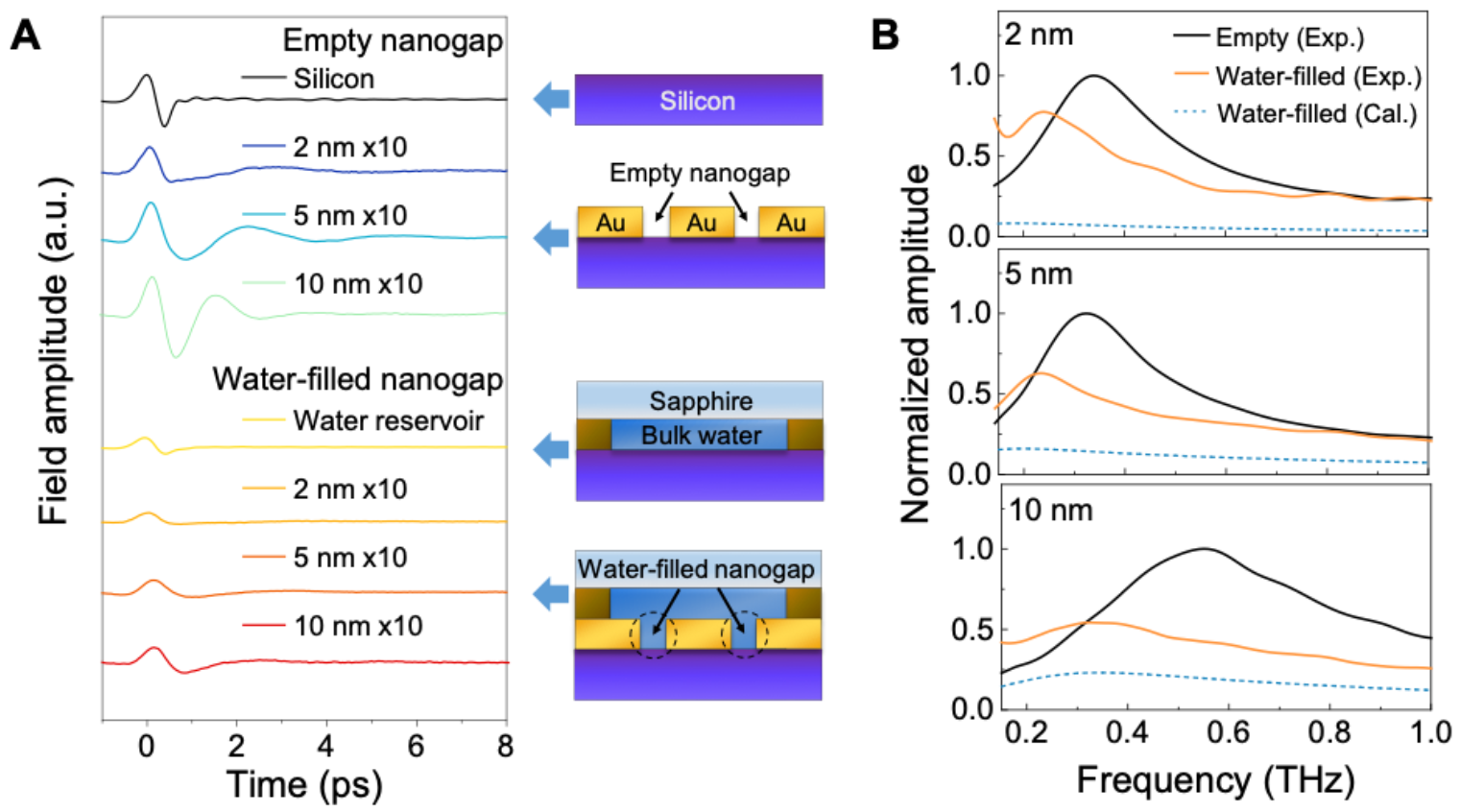| PREVIOUS PRESENTATION | BACK TO PROGRAM OVERVIEW | NEXT PRESENTATION |
Terahertz dynamics of two-dimensional water within nanoresonators
Hyosim Yang1, Gangseon Ji1, Min Choi2, Seondo Park3, Hyeonjun An1, Hyoung-Taek Lee1, Joonwoo Jeong1, Yun Daniel Park3, Kyungwan Kim4, Noejung Park1, Jeeyoon Jeong5, Dai-Sik Kim1, Hyeong-Ryeol Park1,*
1Department of Physics, Ulsan National Institute of Science and Technology, Ulsan 44919, Republic of Korea
2Department of Chemistry, Ulsan National Institute of Science and Technology, Ulsan 44919, Republic of Korea
3Department of Physics and Astronomy, Seoul National University, Seoul 08826, Republic of Korea
4Department of Physics, Chungbuk National University, Chungbuk 28644, Republic of Korea
5Department of Physics and Institute for Quantum Convergence Technology, Kangwon National University, Gangwon 24341, Republic of Korea
*nano@unist.ac.kr
Nanoconfined water is a key system that dictates dynamics of many fundamental phenomena including ion solvation [1], molecular transport [2], and chemical reactions [3]. Although previous studies have demonstrated that interfacial water is ordered within a thickness of 1 nm, the control and measurement of its permittivity have been challenging. A breakthrough, however, has been achieved through the use of van der Waals assemblies of two-dimensional materials and electrostatic force microscopy (EFM) for the precise measurement of permittivity [4]. Despite extensive research in static permittivity, similar progresses in its high frequency counterpart have been lacking. A nanogap structure offers a promising solution because it provides both nanoconfinement and increased sensitivity [5]. By filling nanometer-wide gaps with water molecules, we can systematically investigate nanoconfined water at different thicknesses, enabled by atomic layer lithography for wafer-scale fabrication. As a result of this advance, it is possible to study vertically oriented nanometer-thick water layers, shedding light on long-range hydrogen bond networks that were previously unreachable.

Figure 1: (A) Terahertz time traces transmitted through nanogap samples with different gap widths, comparing empty and water-filled gaps, alongside bare silicon substrates with and without a water reservoir. Time traces are offset for clarity, with magnified traces for 2, 5, and 10 nm gaps to emphasize small-scale fluctuations. Corresponding sample schematics are depicted in the right panel. (B) Normalized transmitted amplitude spectra of empty and water-filled nanogaps (orange) for 2, 5, and 10 nm widths. Analytically calculated normalized field spectra (blue dashed lines) assume bulk-like properties for the gap-filling water.
Optical measurements were conducted on water-filled rectangular loop nanogaps ranging from 2 to 20 nm in gap width. Throughout this study, we measured the refractive indices of nanoconfined water at frequencies ranging from 0.1 to 1.5 terahertz (THz). This analysis enables insights into the long-range collective dynamics of water molecules. Fig. 1A presents the time-domain transmission signals of empty and water-filled nanogaps, as well as their respective reference signals. The time traces of narrower gaps exhibit longer oscillation periods compared to their 10 nm counterparts, indicating resonances at lower frequencies due to stronger gap plasmon coupling. Upon filling the gap with water, a notable suppression of tailing oscillation is observed, attributed to absorption introduced by the water. In Fig. 1B, the corresponding frequency-domain transmission spectra are shown, obtained by Fourier-transforming the time traces in Fig. 1A. Introducing water into the nanogap leads to a redshift in all resonant peaks and a decrease in peak amplitude. Notably, the decrease in amplitude is less pronounced in narrower gaps, contrary to expectations given their larger spectral responses to changes in the dielectric environment near the gap. This observation is supported by analytically calculated spectra (blue dashed lines) using the coupled-mode method with the refractive indices of bulk water. These experimental results suggest that gap-filling water exhibits a lower dielectric permittivity in the THz region when the gap is narrower, consistent with earlier findings in static and infrared regimes [4, 6]. We attempted to quantitatively estimate the complex refractive index of confined water. For 2 nm gap, there is a significant decrease in the refractive index Meanwhile, the extinction coefficient undergoes a more pronounced change, eventually reaching zero. As the gap width increases, the complex refractive index recovers its bulk water properties, but this trend is not well explained by the 3-layer capacitor model, which consists of two interfacial and intermediate water layers proposed in Ref. [4]. We found that intermediate waters were also suppressed by confinement effect, resulting in suppressing the long-range collective motion of water. Using the vibrational density of state (VDOS) model, the number of P show linear trend with respect to gap width, suggesting that suppressed degree of freedom by the confinement might be volumetric. In this work, our findings indicate that, in addition to the well-known interfacial effect, the confinement effect has also been found to significantly reduce the complex refractive index of nanoconfined water by reducing the vibrational modes of low energy, even at gap widths as large as ten nanometers. Therefore, our scheme offers a new approach to the study and utilization of water-mediated processes such as protein folding, lipid rafts, and molecular recognition.
References
[1] M. C. Bellissent-Funel et al., “Water Determines the Structure and Dynamics of Proteins.” Chem. Rev. 116, 7673-7697 (2016).
[2] P. Biswas, D. Sen, M. Prasher, S. K. Sarkar, K. Dasgupta, “Confinement driven anomalous freezing in nano porous spray dried microspheres.”
Nanotechnology 32, 523-534 (2021).
[3] M. Kasuya, D. Kubota, S. Fujii, K. Kurihara, “Nano-confined electrochemical reaction studied by electrochemical surface forces apparatus.” Faraday
Discuss. 233, 206-221 (2022).
[4] L. Fumagalli et al., “Anomalously low dielectric constant of confined water”. Science 360, 1339-1342 (2018).
[5] X. S. Chen et al., “Atomic layer lithography of wafer-scale nanogap arrays for extreme confinement of electromagnetic waves.” Nat. Commun. 4, 2361
(2013).
[6] T. H. H. Le, A. Morita, T. Tanaka, “Refractive index of nanoconfined water reveals its anomalous physical properties.” Nanoscale Horiz. 5, 1016-1024
(2020).
